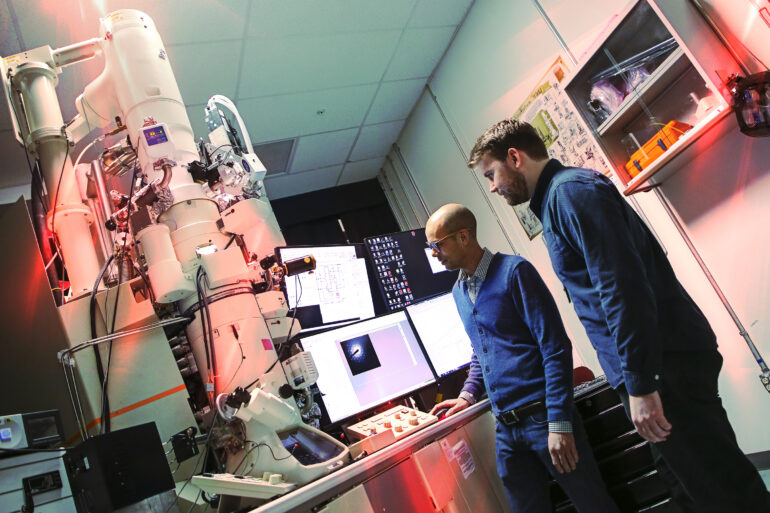When self-propelling objects interact with each other, interesting phenomena can occur. Birds align with each other when they flock together. People at a concert spontaneously create vortices when they nudge and bump into each other. Fire ants work together to create rafts that float on the water’s surface.
While many of these interactions happen through direct contact, like the concert-goers’ nudging, some interactions can transmit through the material the objects are on or in—these are known as indirect interactions. For example, a bridge with pedestrians on it can transmit vibrations, like in the famous Millennium Bridge “wobbly bridge” instance.
While the results of direct interactions (like nudging) are of increasing interest and study, and the results of indirect interactions through mechanisms like vision are well-studied, researchers are still learning about indirect mechanical interactions (for example, how two rolling balls might influence each other’s movement on a trampoline by indenting the trampoline’s surface with their weight, thus exerting mechanical forces without touching).
Physicists are using small wheeled robots to better understand these indirect mechanical interactions, how they play a role in active matter, and how we can control them. Their findings, “Robotic swimming in curved space via geometric phase” are recently published in the The Proceedings of the National Academy of Sciences.
In the paper, led by Shengkai Li, former Ph.D. student in the School of Physics at Georgia Tech, now a Center for the Physics of Biological Function (CPBF) fellow at Princeton University, researchers illustrated that active matter on deformable surfaces can interact with others through non-contact force—then created a model to allow control of the collective behavior of moving objects on deformable surfaces through simple changes in the engineering of the robots.
Co-authors include Georgia Tech School of Physics co-authors Daniel Goldman, Dunn Family Professor; Gongjie Li, assistant professor; and graduate student Hussain Gynai—along with Pablo Laguna and Gabriella Small (University of Texas at Austin), Yasemin Ozkan-Aydin (University of Notre Dame), Jennifer Rieser (Emory University), Charles Xiao (University of California, Santa Barbara).
The significance of this research spans from biology to general relativity. “The mapping to general relativistic systems is a breakthrough in bridging together the field of general relativistic dynamics and that of active matter,” Li, of Georgia Tech, explained. “It opens a new window to better understand the dynamical properties in both fields.”
“Our work is the first to introduce the view that an active matter system can be recast as a dynamical space-time geometry—and thus gain an understanding of the system by borrowing the tools of Einstein’s theory of general relativity,” added Laguna.
Setting the stage
The researchers built robots that drove at a constant speed over flat, level ground. When encountering a surface with dips and curves, these robots maintained that constant speed by reorienting themselves and turning. The amount that the robot turned was a result of how steep the slope or curve was.
When these robots were placed on a circular, trampoline-like surface, the researchers were able to monitor how the robots turned in response to the changing surface, because the robots created new dips in the surface as they moved, depressing it with their weight. An overhead system tracked the robots’ progress across the trampoline, recording their courses.
The researchers began by testing how just one robot might move across the trampoline, and found that they could construct a mathematical model to predict how the vehicle would move. By using tools from general relativity to map the orbits to the motion in a curved spacetime, they showed that one could qualitatively change the precession by making the vehicle lighter. This model explains the orbital property: how the movement of the “loops” (the precession of the aphelion) depend on the initial condition and the trampoline’s central depression.
“We were excited and amused that the paths the robot took—precessing ellipses— looked a lot like those traced by celestial bodies like Mars and explained by Einstein’s theory of General Relativity,” said Goldman, of Georgia Tech Physics.
Multi-robot interactions
When more robots were added to the trampoline, the researchers found that the deformations caused by each robot’s weight changed their paths across the trampoline.
The researchers hypothesized that increasing the speed of the robots by changing the tilt of the robot’s body might help mitigate the collisions they observed. After several tests with two vehicles, they were able to confirm their theory.
The researchers’ solution held when more robots were added to the surface, as well.
Then, the researchers varied the robots’ speed instantaneously, adjusting the tilt by using a microcontroller and in-the-moment readings from an internal measurement unit.
Finally, the researchers used their observations to create a model for the multi-robot case. “To understand how the elastic membrane deformed when multiple vehicles were present, we envisioned the membrane as many infinitesimal, connected springs forming the surface; the springs can deform when vehicles move over them,” Li, of Princeton University, explained.
In the simulation created using the researchers’ spring model, the two vehicles move and merge, attracting each other indirectly through the deformation of the elastic membrane beneath, sometimes resulting in collision, just like when the team placed multiple robots on a trampoline.
The overall model works to guide designs of engineering schemes—like speed and tilt of the researchers’ robots—to control the collective behavior of active matter on deformable surfaces (for example, whether the robots collide on the trampoline or not).
From robotics to general relativity: interdisciplinary applications
For researchers using biomimicry to build robots, the team’s work could help inform robotics designs that avoid or utilize aggregation. For example, the SurferBot, a simple vibrobot, can skim the water’s surface, and was originally inspired by honeybees working their way out of water. Other systems that could potentially inspire biomimicking robots include ducklings swimming after their mother. By incorporating this work on aggregation into their design, the research could also help these robots work together to collectively accomplish tasks.
Researchers add that the work could also advance the understanding of general relativity.
“Our conventional visualization of general relativity is of marbles rolling on an elastic sheet,” explained Li, the paper’s lead author. “That visual demonstrates the idea that matter tells spacetime how to curve, and spacetime tells matter how to move. Since our model can create steady-state orbits, it can also overcome common issues in previous studies: with this new model, researchers have the ability to map to exact general relativity systems, including phenomena like a static black hole.”
More information:
Shengkai Li et al, Robotic swimming in curved space via geometric phase, Proceedings of the National Academy of Sciences (2022). DOI: 10.1073/pnas.2200924119
Provided by
Georgia Institute of Technology
Citation:
Active matter, curved spaces: Mini robots learn to ‘swim’ on stretchy surfaces (2022, September 28)



